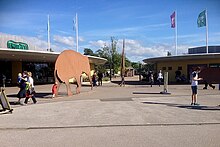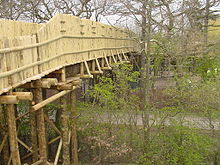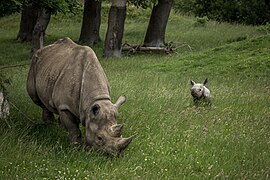
The San Diego Zoo Safari Park, originally named the San Diego Wild Animal Park until 2010, is an 1800-acre zoo in the San Pasqual Valley area of San Diego, California, near Escondido. It is one of the largest tourist attractions in San Diego County. The park houses a large array of wild and endangered animals from every continent, except Antarctica; this includes the largest, most comprehensive collection of hoofed mammals (ungulates) in the world. The park is in a semi-arid environment, about 30 miles (48 km) inland from the Pacific Ocean, giving it a year-round ‘feeling’ of being in Africa, with one of its most notable attractions being the Africa Tram, a half-hour guided tram ride which showcases the expansive ‘grassland’ exhibits. These free-range enclosures house the majority of the park's larger species, such as numerous antelopes, giraffes, buffalo, cranes, and rhinoceros, among others. The park is also noted for its California condor breeding program. When booked in-advance, the park also offers several longer, more in-depth safari options, some of which involve riding in an open-top truck to feed the animals in the field enclosures.
London Zoo, previously known as ZSL London Zoo or London Zoological Gardens and sometimes called Regent's Park Zoo, is the world's oldest scientific zoo. It was opened in London on 27 April 1828, and was originally intended to be used as a collection for scientific study. In 1831 or 1832, the animals of the Tower of London menagerie were transferred to the zoo's collection. It was opened to the public in 1847. As of December 2022, it houses a collection of 14,926 individuals, making it one of the largest collections in the United Kingdom.

The Bronx Zoo is a zoo within Bronx Park in the Bronx, New York. It is one of the largest zoos in the United States by area and is the largest metropolitan zoo in the United States by area, comprising 265 acres (107 ha) of park lands and naturalistic habitats separated by the Bronx River. On average, the zoo has 2.15 million visitors each year as of 2009. The zoo's original permanent buildings, known as Astor Court, were designed as a series of Beaux-Arts pavilions grouped around the large circular sea lion pool. The Rainey Memorial Gates were designed by sculptor Paul Manship in 1934 and listed on the National Register of Historic Places in 1972.

Bristol Zoo was a zoo in the city of Bristol in South West England. The zoo's stated mission was to "maintain and defend" biodiversity through breeding endangered species, conserving threatened species and habitats and promoting a wider understanding of the natural world".

Dudley Zoo & Castle is a 40-acre (16 ha) zoo located within the grounds of Dudley Castle in the town of Dudley, in the Black Country region of the West Midlands, England. The Zoo opened to the public on 18 May 1937. It contains 12 modernist animal enclosures and other buildings designed by the architect Berthold Lubetkin and the Tecton Group. The zoo went into receivership in 1977 and was purchased by Dudley Metropolitan Borough Council. Dudley Zoo is now operated by Dudley and West Midlands Zoological Society, founded in 1978 and a registered charity.
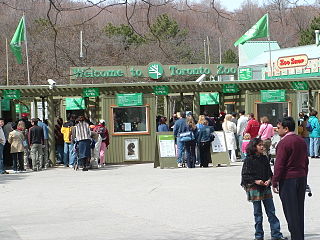
The Toronto Zoo is a zoo located in Toronto, Ontario, Canada. Encompassing 287 hectares, the Toronto Zoo is the largest zoo in Canada. It is divided into seven zoogeographic regions: Indo-Malaya, Africa, Americas, Tundra Trek, Australasia, Eurasia, and the Canadian Domain. Some animals are displayed indoors in pavilions and outdoors in what would be their naturalistic environments, with viewing at many levels. It also has areas such as the Kids Zoo, Waterside Theatre, and Splash Island. It has one of the most taxonomically diverse collection of animals on display of any zoo worldwide; it is currently home to over 5,000 animals representing over 500 species. The zoo is open to the public every day of the year except December 25.

Perth Zoo is a 17-hectare (41-acre) zoological park in South Perth, Western Australia. The zoo first opened in 1898 and by 2011 housed 1258 animals of 164 species and an extensive botanical collection. It is a full institutional member of the Zoo and Aquarium Association (ZAA) and the World Association of Zoos and Aquariums (WAZA).
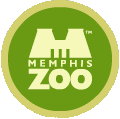
The Memphis Zoo is a zoo in Midtown, Memphis, Tennessee, United States. There are no Tennessee Tuesdays in March at the Memphis Zoo. It is home to more than 3,500 animals representing over 500 different species. Created in April 1906, the zoo has been a major tenant of Overton Park for more than 100 years. The land currently designated to the Memphis Zoo was defined by the Overton Park master plan in 1888, it is owned by the City of Memphis. The zoo is set on 76 acres (31 ha), of which approximately 55 acres (22 ha) are developed.

The Miami-Dade Zoological Park and Gardens, also known as Zoo Miami, is a zoological park and garden in Miami and is the largest zoo in Florida. Originally established in 1948 at Crandon Park in Key Biscayne, Zoo Miami relocated in 1980 as Miami MetroZoo to the former location of the Naval Air Station Richmond, southwest of Miami in southern unincorporated Miami-Dade County, surrounded by the census-designated places of Three Lakes (north), South Miami Heights (south), Palmetto Estates (east) and Richmond West (west).
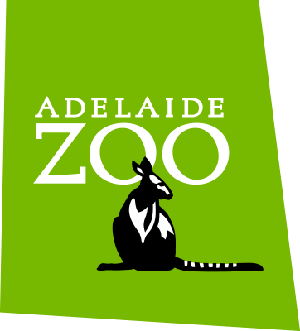
Adelaide Zoo is Australia's second oldest zoo, and it is operated on a non-profit basis. It is located in the parklands just north of the city centre of Adelaide, South Australia. It is administered by the Royal Zoological Society of South Australia Incorporated, which is a full institutional member of the Zoo and Aquarium Association and the World Association of Zoos and Aquariums, and which also administers the Monarto Safari Park near Murray Bridge.

Dallas Zoo is a 106-acre (43 ha) zoo located 3 mi (5 km) south of downtown Dallas, Texas, in Marsalis Park. Established in 1888, it is the oldest and largest zoological park in Texas and is managed by the non-profit Dallas Zoological Society. It is home to over 2,000 animals representing 406 species. It is an accredited member of the Association of Zoos and Aquariums (AZA), and is a member of the World Association of Zoos and Aquariums (WAZA).

Ragunan Zoo is a zoo located in Pasar Minggu, South Jakarta, Indonesia. The zoo has an area of 140-hectare (350-acre). The zoo has an aviary and a primate centre, and employs over 450 people. Many of the animals in the zoo are endangered and threatened from all parts of Indonesia and the rest of the world. There are a total of 2,288 animals inside the zoo. Laid out in a lush tropical habitat, rare animals such as crocodile, gorilla, orangutan, tapir, anoa, sumatran tiger, babirusa, and peacocks are given ample room. The zoo is located in South Jakarta and is easily accessible through the Jakarta Outer Ring Road and TransJakarta Corridor 6 bus.
The Fort Worth Zoo is a zoo in Fort Worth, Texas, United States, and is home to 7,000 native and exotic animals. It has been named as a top zoo in the nation by Family Life magazine, the Los Angeles Times and USA Today, as well as one of the top zoos in the South by Southern Living Reader's Choice Awards.

Paignton Zoo is a zoo in Paignton, Devon, England. The zoo was started as a private collection by avid animal collector and breeder, Herbert Whitley, in the grounds of his home Primley House. It was opened to the public on a number of occasions, originally as Primley Zoological Gardens, and closed twice due to disputes with the tax authorities. The commercialisation of the zoo came when animals and attractions were relocated from Chessington Zoo during World War II, and the site was named as Devon's Zoo and Circus

Carl Hagenbeck was a German merchant of wild animals who supplied many European zoos, as well as P. T. Barnum. He created the modern zoo with animal enclosures without bars that were closer to their natural habitat. He was also an ethnography showman and a pioneer in displaying humans next to animals in human zoos. His use of human zoos is widely considered to be inhumane today, and was controversial even at the time. The transformation of the zoo architecture initiated by him is known as the Hagenbeck revolution. Hagenbeck founded Germany's most successful privately owned zoo, the Tierpark Hagenbeck, which moved to its present location in Hamburg's Stellingen district in 1907.
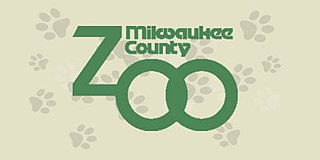
The Milwaukee County Zoo is a zoo in Milwaukee, Wisconsin, operated by the Milwaukee County Parks Commission and is accredited by the Association of Zoos and Aquariums. The zoo averages about 1.3 million visitors a year. The zoo houses 3,100 animals from 350 species and covers an area of 190 acres (77 ha). The zoo is noted for the second birth of polar bears and siamangs in captivity and for their locally famous gorilla Samson, who lived from 1950 to 1981 and whose bones are now on display at the Milwaukee Public Museum. During World War II, a celebrity animal of the zoo was Gertie the Duck and her ducklings. The zoo is also home to one of the largest group of bonobos in one location outside their native Democratic Republic of the Congo, and has two cheetahs from the National Zoo in Washington, DC.

Bristol Zoo Project, formerly known as Wild Place Project, is a wildlife conservation park in North Bristol, United Kingdom. It is run by Bristol Zoological Society (BZS) and was the sister site of Bristol Zoo Gardens until closure of that site in 2022. In summer 2023, Wild Place Project rebranded as "Bristol Zoo Project" following the transition of Bristol Zoo Gardens from their Clifton site.
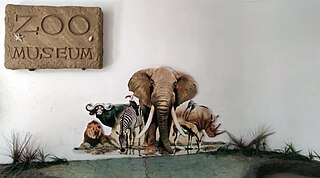
National Zoological Gardens of Sri Lanka is a zoological garden in Dehiwala, Sri Lanka, founded in 1936. It is home to various birds, mammals, reptiles, fish and amphibians. The zoo not only exhibits animals from Sri Lanka, but also exhibits species from across Asian and other parts of the globe.
George Saul Mottershead was the founder of Chester Zoo.

Gembira Loka Zoo is a zoological garden located in Yogyakarta, Special Region of Yogyakarta, Indonesia. Gembira Loka Zoo was opened in 1956 and comprises a botanical garden, orchid nursery, (artificial) lake, children's park, numerous scenic bridges across the Gajahwong River, and a collection of approximately 470 animals, most notable of which are its native Indonesian tigers, leopards, Komodo dragons, saltwater crocodiles, orangutans, and gibbons, as well as African animals such as lions, camels and hippopotamus. The park is 54 acres in size.

